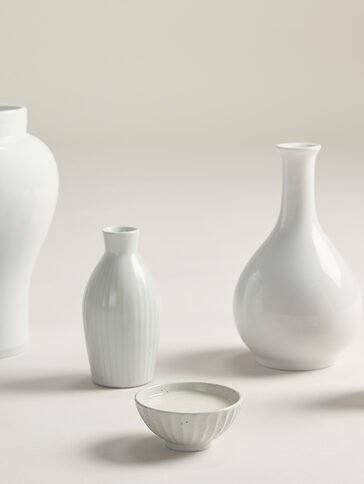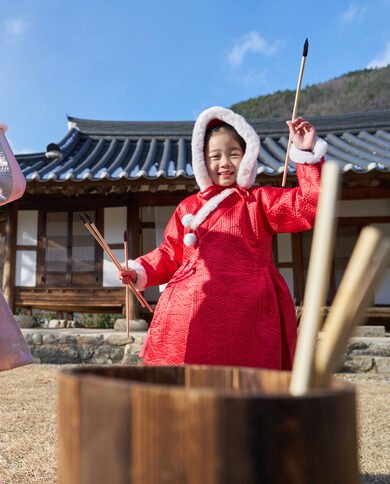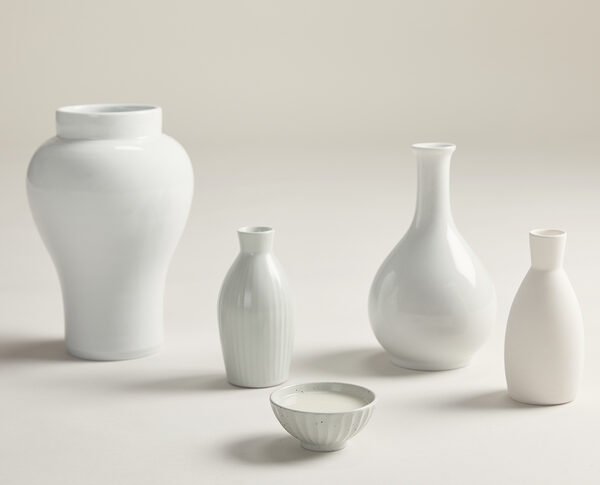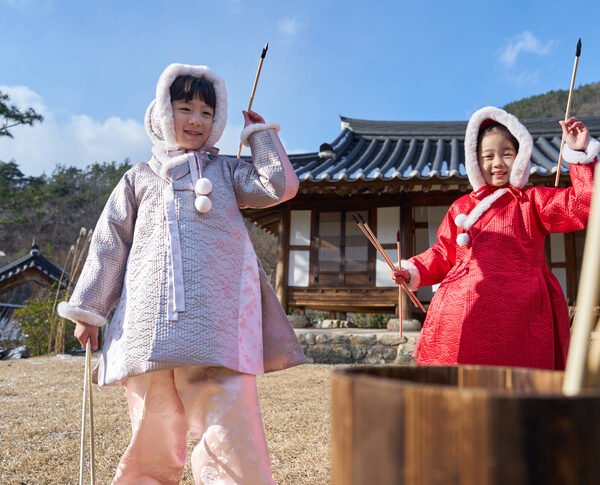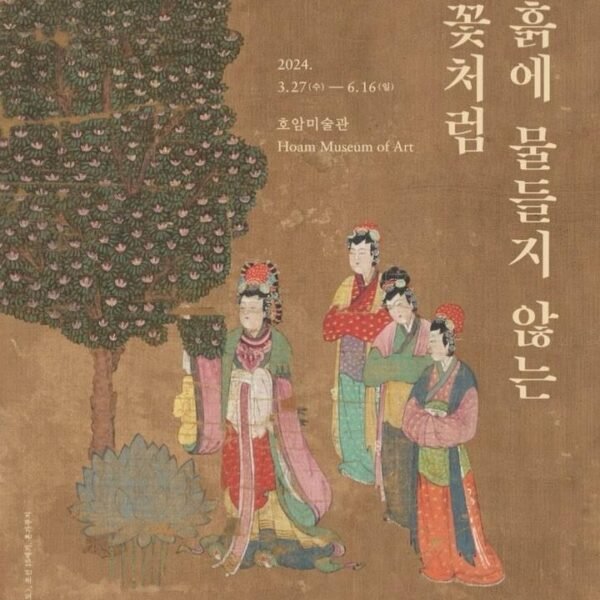Table of Contents
ToggleIntroduction
Seoul, the bustling capital of South Korea, not only showcases its modern urban landscape but also hides treasures in its narrow alleys, blending ancient traditions with contemporary allure. One such hidden gem is Seosunla-gil, a quaint alleyway following the path once patrolled by the Chosun-era security guards known as “Sunla-gun.” Let’s embark on a 3-hour journey through Seosun-gil, exploring the authentic charm of Seoul where tradition and modernity coexist harmoniously.
Here is a blog written with reference to the information provided by the Korea Tourism Organization about Seosunla Road.
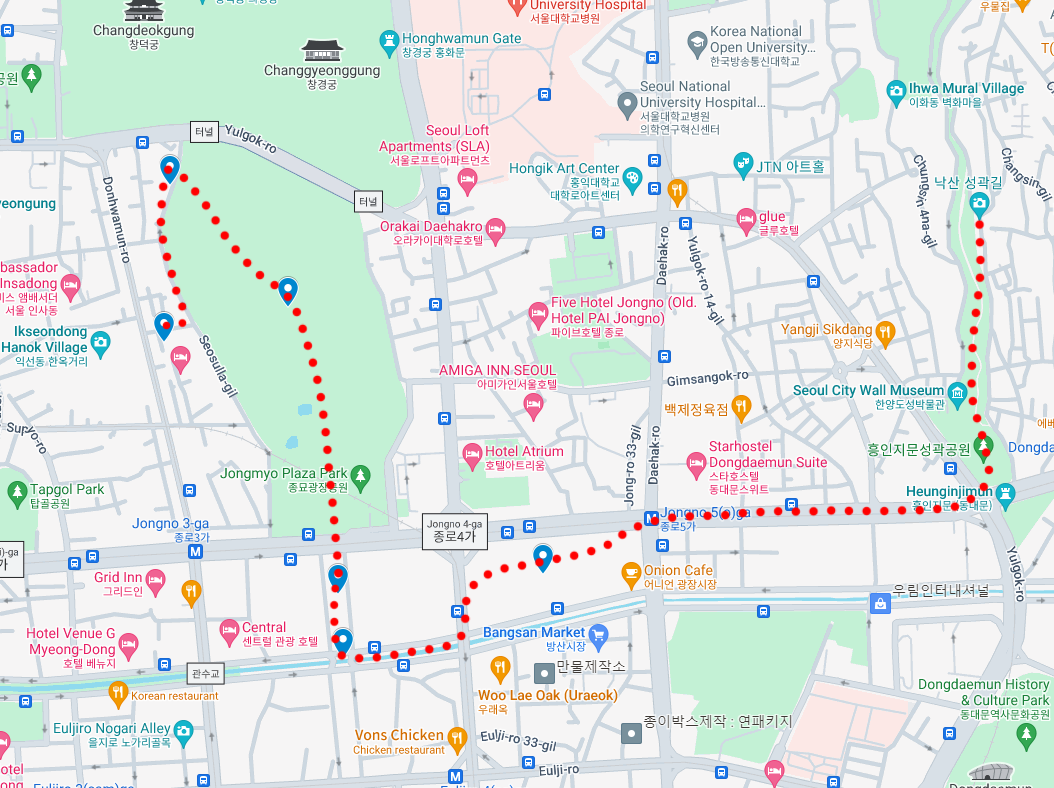
Unveiling Seosunla-gil: Where Tradition Meets Modernity
Seosunla-gil, approximately 800m long, winds along the Jongmyo Stone Wall, a route where Sunla-gun safeguarded the security of Chosun’s capital. Today, it blends traditional Hanok architecture with renovated restaurants, cafes, and hidden jewelry workshops, creating a perfect fusion of past and present.
Things to see and eat on Seosunla-gil
1. 잘빠진 메밀: Savoring the Essence of Buckwheat
Introducing ‘JalBbaJin Memil,’ which presents traditional Korean dishes made with healthy ingredients like buckwheat. The signature menu includes three variations of seasoned buckwheat noodles with different sauces. Choose from refreshing and clean water buckwheat noodles, spicy bibim buckwheat noodles with a kick, and sesame oil buckwheat noodles flavored with a special blend of sesame oil and soy sauce. Notably, the buckwheat used here retains its pure flavor without the addition of wheat flour, setting it apart from commonly available buckwheat noodles in the market. Another popular item is the buckwheat dumplings, available in both steamed and fried options. During the winter season, the ‘Buckwheat Flower Dumpling Hot Pot Feast’ is a favorite, featuring buckwheat dumplings boiled in a flavorful broth.
-
- Location: JalBbaJin Memil
- Address: 173 Yulgok-ro 8-gil, Jongno-gu, Seoul
- Operating Hours: Mon-Fri 11:00 ~ 21:30, Sat-Sun 11:00 ~ 21:30 (break time 15:30 ~ 16:30)
- Contact: 0507-1441-1214
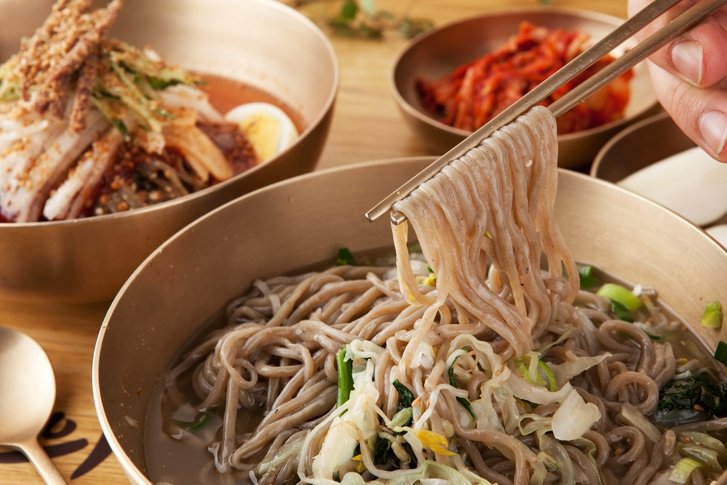
2. Cafe Sasa: Traditional Desserts in a Hanok Setting
After indulging in buckwheat noodles, continue exploring the charm of Korean cuisine with traditional desserts and beverages at Cafe Sasa, located just a 5-minute walk from Well-Seasoned Buckwheat. This hanok cafe offers reinterpretations of traditional desserts and drinks. For a truly Korean dessert experience, try the ‘Sasa Hansang Tea Set,’ which consists of baked galette made with glutinous rice cake and traditional makgeolli liquor. The chewy texture of glutinous rice cake, paired with sweet condensed syrup and fine soybean flour, enhances the flavor. Cafe Sasa also serves non-alcoholic makgeolli, providing an opportunity for those who don’t enjoy alcohol to savor the unique taste. If you’re in the mood for a refreshing Korean dessert, the ‘Gwopyeon’ is an excellent choice. Made with seasonal fruits, this sherbet-style fruit jelly combines fruit juice with mung bean starch, sugar, and honey, reminiscent of Western fruit jellies. The cafe’s serene atmosphere, named after the sound of the wind in the forest, offers a beautiful view of Seosunla Road’s stone walls from the first floor and a panoramic view of Jongmyo’s walls and surrounding hanoks from the second floor.
-
- Location: Cafe Sasa
- Address: 147 Seosun-ro, Jongno-gu, 1-2F
- Operating Hours: Mon-Fri 12:00 PM – 7:00 PM, Sat-Sun 12:30 PM – 7:00 PM
- Contact: 02-762-7001
3. Jongmyo: Resting Place for the Spirits of Past Kings
As you stroll along Seosunla Road, curiosity naturally arises about what lies beyond the stone walls. To find the answer, head to Jongmyo, located just beyond the stone walls. Jongmyo is a shrine where tablets inscribed with the names of kings and queens from the Joseon Dynasty are enshrined. Although it was lost in a fire during the Japanese invasions of Korea, it was rebuilt and retains its present form. What makes Jongmyo even more special is that actual ceremonies are still held here, honoring the spirits of the kings and queens every year in May and November. This cultural heritage was recognized, leading to Jongmyo’s designation as a UNESCO World Cultural Heritage site in 1995.
-
- Address: 157 Jong-ro, Jongno-gu
- Operating Hours: Time-specific tours (varies by language) / General admission (Sat, Sun, holidays, last Wed of each month)
- Entrance Fee (March ’23): Adults 1,000 KRW, Foreigners (19-64 years old) 1,000 KRW (Free with Hanbok attire)
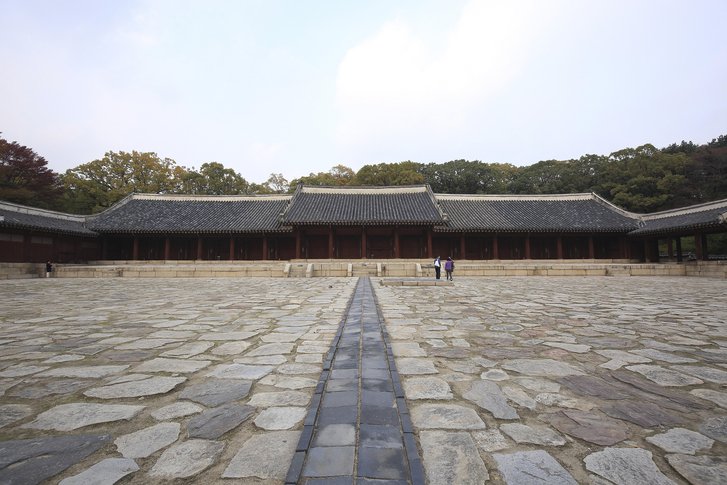
4. Seun Sangga: A Crossroads of Seoul’s Past and Present Filming Location
Right across from Jongmyo, just a 3-minute walk away, Seun Sangga unfolds another aspect of Korea. As the first mixed-use complex building in South Korea, Seun Sangga embodies the history of the country’s electrical and electronic industries in the 1970s and 1980s. The aged scenery has its own charm, but the recent resurgence of Seun Sangga’s popularity is thanks to trendy spaces like the retro-themed cafe ‘Horang-i’ and the philosophical bookstore ‘Soyo Seoga.’ Through urban renewal projects redeveloping old buildings, it has transformed into a modern space where one can simultaneously experience Seoul’s past and present. Additionally, Seun Sangga gained attention as the filming location for the popular drama ‘Vincenzo,’ which achieved Netflix chart-topping success in various regions such as Singapore, Taiwan, Thailand, and the Philippines during its broadcast. The ‘Geumga Plaza,’ a key setting in the drama, is none other than Seun Sangga. If you’re a fan of ‘Vincenzo,’ it’s worth exploring Seun Sangga while recalling scenes from the drama.
-
- Location: Seun Sangga
- Address: 159 Cheonggyecheon-ro, Jongno-gu
5. Cheonggyecheon: Another Culinary Alley in Seoul
While walking through Seun Sangga, you’ll notice a flowing stream under the elevated pedestrian deck, which is none other than Cheonggyecheon, where urban and natural elements coalesce. Stretching approximately 5.8 kilometers from Cheonggye Square, it serves as a sanctuary and promenade for Seoul citizens. Hosting festivals during year-end and beginning-of-year celebrations, Cheonggyecheon is a major cultural hub. Starting from Seun Sangga and heading east along the stream, you’ll encounter diverse aspects of Seoul, including Gwangjang Market, the Dongdaemun Chicken Alley, and the second-hand bookstore street.
-
- Location: Seoul Tourism Plaza Tourist Information Center (near Cheonggyecheon)
- Address: 85 Cheonggyecheon-ro, Jongno-gu
- Contact: 02-6365-3100
- Operating Hours: 9:00 AM – 6:00 PM
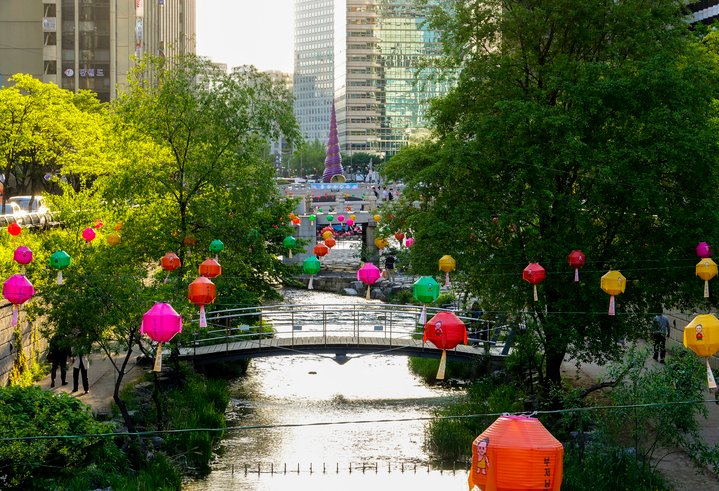
6. Kwangjang Market: Exploring Local Street Food Along Seoul’s Urban Paths
With a history of over 110 years, Kwangjang Market is a permanent market offering the enjoyment of various street foods like bindaetteok (mung bean pancakes), mayak gimbap (drug rolls), and yukhoe (Korean-style beef tartare). Additionally, in the nearby Chicken Alley, you can try the unique dish ‘One Whole Chicken,’ where a whole chicken is boiled in a large pot and served with a mild broth.
-
- Location: Kwangjang Market
- Address: 88 Changgyeonggung-ro, Jongno-gu, Seoul
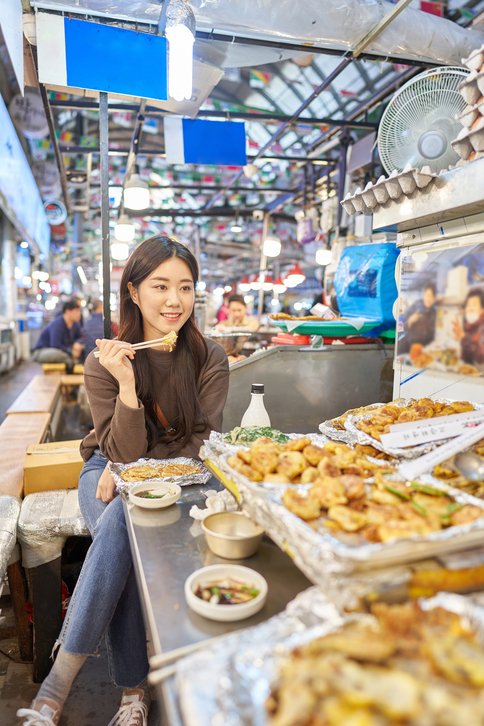
7. Hanyangdoseong Fortress Circular Trail: Strolling through the Castle City
Having followed the waterway, it’s time to walk along the Hanyangdoseong Fortress surrounding the city of Seoul. Built to protect the capital during the Joseon Dynasty, the Hanyangdoseong Fortress still preserves its original shape despite the passage of time. The circular trail along the fortress consists of six sections, with the Nak-san section starting from the Heungin Gate and extending to Hyehwa Gate. Conveniently located approximately 10 minutes on foot from Cheonggyecheon’s second-hand bookstore street, it’s an ideal spot to explore.
-
- Location: Hanyangdoseong Fortress
- Address: 70 Jongno 6-ga, Jongno-gu, Seoul
- Operating Hours: Open 24 hours
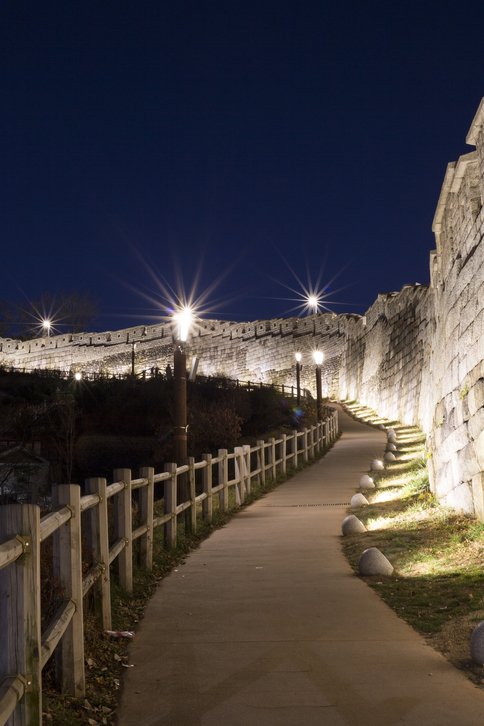
8. 우리술집 다람쥐: Traditional Pub Showcasing Korean Ingredients
After enjoying the blend of traditional and modern on this alley trip, conclude your journey with fusion cuisine at the traditional pub ‘Woori Sooljip Daramji.’ The signature menu, Jeju Pisundae Gui, features intestines stuffed with ingredients and seasoned with a choice of two sauces – a spicy makjang sauce with Cheongyang chili peppers and a truffle mayo sauce. These sauces, one inspired by Korean-style makjang made with fermented soybeans and the other a Western-style truffle mayo, provide contrasting flavors worth trying. Another popular dish, the Tohajot Pasta, incorporates the savory taste of Tohajot, a fermented shrimp paste from Gangjin. As a representative fermented food in Korea, Tohajot adds a unique and pungent flavor to the spaghetti. Woori Sooljip Daramji offers a variety of traditional Korean liquors. If ordering a whole bottle seems overwhelming, try the ‘Tap Makgeolli’ for a leisurely experience, sipping one glass at a time.
-
- Location: Woori Sooljib Darangui
- Address: 101 Seosun-ro, 1F
- Operating Hours: Tue-Fri 5:00 PM – 11:30 PM, Sat-Sun 4:00 PM – 11:30 PM (Closed every Monday)
- Contact: 070-4258-8880
Conclusion
Taking inspiration from the details shared by the Korea Tourism Organization about Seosunla Road, this piece captures the essence of the journey along this enchanting path.
Seosunla-gil unfolds the genuine allure of Seoul, seamlessly blending the historical richness of the past with the vibrant spirit of today. Embark on this gastronomic and cultural journey to discover the heart and soul of the city, where each alleyway tells a unique story. Explore the hidden gems, relish the fusion of flavors, and witness Seoul’s true essence.
Related posts:
- Why Korean Fine Dining in New York Feels French: Exploring the Fusion of Culinary Traditions
- Art Road: Experience the Beauty of Traditional Art in Korea
- Unveiling the Beauty of Hanok: Korea’s Traditional Architectural Marvel
- Exploring the Rich Flavors of Korean Cuisine
- Summit Stories: Exploring Korea’s 10 Majestic Mountains perfect for hiking
- Cheong Wa Dae: Exploring the Grandeur of South Korea’s Presidential Blue House
- Exploring the Exquisite Flavors of Royal Cuisine in Korea


